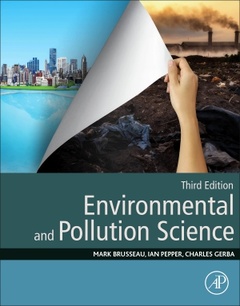Description
Environmental and Pollution Science (3rd Ed.)
Authors: Brusseau Mark L., Pepper Ian, Gerba Charles
Language: English
132.33 €
In Print (Delivery period: 14 days).
Add to cart656 p. · 21.4x27.6 cm · Paperback
Description
/li>Contents
/li>Readership
/li>Biography
/li>Comment
/li>
PART 1 Fundamental Concepts1. The Extent of Global Pollution2. Physical-Chemical Characteristics of Soils and the Subsurface3. Physical-Chemical Characteristics of Waters4. Physical-Chemical Characteristics of the Atmosphere5. Microbial Characteristics of the Environment6. Ecosystems and Ecosystem Services7. Physical Processes Affecting Contaminant Transport and Fate8. Chemical Processes Affecting Contaminant Transport and Fate9. Biological Processes Affecting Contaminant Transport and Fate
PART 2 Environmental Pollution10. The Role of Environmental Monitoring in Pollution Science11. Physical Contaminants12. Chemical Contaminants13. Microbial Contaminants14. Soil and Land Pollution15. Subsurface Pollution16. Surface Water Pollution17. Atmospheric Pollution18. Urban and Household Pollution
PART 3 Remediation, Restoration, Treatment, and Reuse19. Soil and Groundwater Remediation20. Ecosystem Restoration and Land Reclamation21. Industrial and Municipal Solid Waste Treatment and Disposal22. Municipal Wastewater Treatment23. Land Application of Biosolids and Animal Wastes24. Drinking Water Treatment and Water Security
PART 4 Global Systems and the Human Dimensions to Environmental Pollution25. Pollution and Environmental Perturbations in the Global System26. Environmental Human Health27. Medical Geology and the Soil Health: Human Health Nexus28. Environmental Toxicology29. Risk Assessment30. Environmental Laws and Regulations31. Environmental Justice32. Sustainable Development and Other Solutions to Pollution and Global Change33. Epilogue: Is the Future of Pollution History?
Professionals and students focused on the environment including environmental science, aquatic sciences, microbiology, hydrology, earth science, environmental engineering, chemistry, physics and biology, in addition to conservationists, ecologists, toxicologists. It is appropriate for a diversity of courses focused on pollution and the environment
Dr. Ian Pepper is a Regents Professor at the University of Arizona and also the Director of the University of Arizona Water and Energy Sustainable Technology Center (WEST). He is an environmental microbiologist whose research has focused on the fate and transport of microbial pathogens in air, water, soils and municipal wastes. His expertise has been recognized by membership on six National Academy of Sciences Committees. Dr. Pepper is a Fellow of the American Association for the Advancement of Science, the American Academy of Microbiology, the Soil Science Society of America, and the American Society of Agronomy. He is the author or co-author of seven textbooks and over 200 peer-reviewed journal articles.
Dr. Charles Gerba is a Professor at the University of Arizona. He conducts research on the transmission of pathogens through the environment. His recent research encompasses the transmission of pathogens by water, food and fomites; fate of pathogens in land applied wastes; development of new disinfectants; domestic microbiology and microbial risk assessment. He has been an author on more than 500 articles including several books in environmental microbiology and pollution science. He is a fellow of the American Academy of Microbiology and the American Association for the Advancement of Science. In 1998 he received the A. P. Black Award from the American Water Works Association for outstanding contributions to water science and in 1996 he received the McKee medal from the Water Envi
- Emphasizes conceptual understanding of environmental systems and can be used by students and professionals from a diversity of backgrounds focusing on the environment
- Covers many aspects critical to assessing and managing environmental pollution including characterization, risk assessment, regulation, transport and fate, and remediation or restoration
- New topics to this edition include Ecosystems and Ecosystem Services, Pollution in the Global System, Human Health Impacts, the interrelation between Soil and Human Health, Environmental Justice and Community Engagement, and Sustainability and Sustainable Solutions
- Includes color photos and diagrams, chapter questions and problems, and highlighted key words




